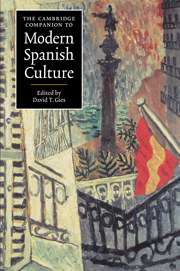Book contents
- Frontmatter
- Modern Spanish culture
- I Culture
- II Culture and history
- III Culture and prose
- IV Culture and poetry
- V Culture and theater
- VI Culture and the arts
- 17 Painting and sculpture in modern Spain
- 18 Culture and cinema to 1975
- 19 Culture and cinema, 1975-1996
- 20 A century of Spanish architecture
- 21 Spanish music and cultural identity
- 22 To live is to dance
- VII Media
- Index
- Series List
18 - Culture and cinema to 1975
from VI - Culture and the arts
Published online by Cambridge University Press: 28 May 2006
- Frontmatter
- Modern Spanish culture
- I Culture
- II Culture and history
- III Culture and prose
- IV Culture and poetry
- V Culture and theater
- VI Culture and the arts
- 17 Painting and sculpture in modern Spain
- 18 Culture and cinema to 1975
- 19 Culture and cinema, 1975-1996
- 20 A century of Spanish architecture
- 21 Spanish music and cultural identity
- 22 To live is to dance
- VII Media
- Index
- Series List
Summary
In his classic 1947 study of the representation of national identity in film, From Caligari to Hitler: A Psychological History of German Film, Siegfried Kracauer underscores the value of popular cinema, commercial genres with their “persistent reiteration of... pictorial and narrative motifs” in the cultural historian's reconstruction of the “inner life of a nation.” In my study of Spanish film before 19751 have sought to attend, at least in part, to Kracauer's view. Thus where many histories of Spanish cinema have focused primarily on the development of a modern Spanish art cinema that largely coincides with the emergence of a dissident anti- Francoist culture, I have been guided by somewhat different concerns. I am more interested in examining the psychic, social, and ideological functions of film in Spanish society, particularly as regards the role of cinema in presenting images of nation and national identity.
To that end I have divided this essay into three chronological blocks, deliberately rejecting the temptation of a continuous historical narrative. This three-part structure allows for the observation of revealing continuities and discontinuities in the history of the Spanish film industry that do not always coincide with those of political history or with the boundaries between popular and art cinemas. The first section deals with the 1930s and 1940s, the period of the Republic, Civil War, and the first decade of Francoism.
- Type
- Chapter
- Information
- The Cambridge Companion to Modern Spanish Culture , pp. 248 - 266Publisher: Cambridge University PressPrint publication year: 1999
- 3
- Cited by



